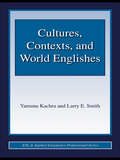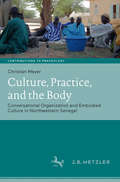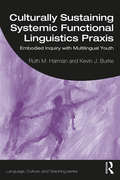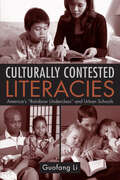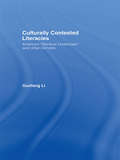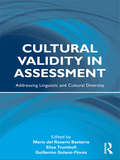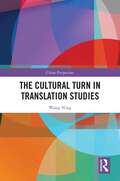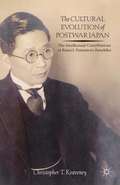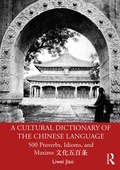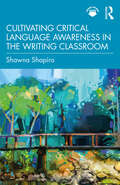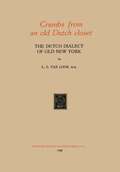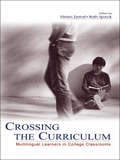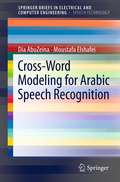- Table View
- List View
Currency Wars with China and Japan in Western Newsmagazines (Routledge Studies in Chinese Discourse Analysis)
by Damien NgThis book explores China’s currency wars with its trading partners in four Western newsmagazines: Time, The Economist, L’Express, and Der Spiegel. Based on both quantitative and qualitative approaches, the interdisciplinary approach adopted in the research draws on two analytical frameworks from the realm of critical discourse analysis; van Leeuwen’s socio-semantic inventory of social-actor representation, and van Dijk’s concepts of macro-rules as the overarching approaches to understand the changing dynamics of international relations and the global economy through Western media. The sample in this study consists of 160 texts, half of which are focused on China and the other half on Japan, across a period of 12 months in 2010 (China) and in 1987 (Japan). Through the comparison of Western representation betwen China and Japan, the similarities and differences in their coverage have been revealed as even more striking, with regards to global politics and the international economy. The findings obtained from the empirical research have revealed that China was not only reported more unfavourably than Japan in terms of depth, but also across a broader range of areas spanning economics, politics, and military affairs. It has also emerged that all the four Western newsmagazines tended to centre their coverage on the United States and China in 2010, and the United States and Japan in 1987, although they did not speak in one collective voice with regard to their coverage of China and Japan.
Currency Wars with China and Japan in Western Newsmagazines (Routledge Studies in Chinese Discourse Analysis)
by Damien NgThis book explores China’s currency wars with its trading partners in four Western newsmagazines: Time, The Economist, L’Express, and Der Spiegel. Based on both quantitative and qualitative approaches, the interdisciplinary approach adopted in the research draws on two analytical frameworks from the realm of critical discourse analysis; van Leeuwen’s socio-semantic inventory of social-actor representation, and van Dijk’s concepts of macro-rules as the overarching approaches to understand the changing dynamics of international relations and the global economy through Western media. The sample in this study consists of 160 texts, half of which are focused on China and the other half on Japan, across a period of 12 months in 2010 (China) and in 1987 (Japan). Through the comparison of Western representation betwen China and Japan, the similarities and differences in their coverage have been revealed as even more striking, with regards to global politics and the international economy. The findings obtained from the empirical research have revealed that China was not only reported more unfavourably than Japan in terms of depth, but also across a broader range of areas spanning economics, politics, and military affairs. It has also emerged that all the four Western newsmagazines tended to centre their coverage on the United States and China in 2010, and the United States and Japan in 1987, although they did not speak in one collective voice with regard to their coverage of China and Japan.
Cultures, Contexts, and World Englishes
by Yamuna Kachru Larry E. SmithThis volume aims to familiarize readers with the varieties of world Englishes used across cultures and to create awareness of some of the linguistic and socially relevant contexts and functions that have given rise to them. It emphasizes that effective communication among users of different Englishes requires awareness of the varieties in use and their cultural, social, and ideational functions. Cultures, Contexts and World Englishes: demonstrates the rich results of integrating theory, methodology and application features critical and detailed discussion of the sociolinguistics of English in the globalized world gives equal emphasis to grammar and pragmatics of variation and to uses of Englishes in spoken and written modes in major English-using regions of the world. Each chapter includes suggestions for further reading and challenging discussion questions and appropriate research projects designed to enhance the usefulness of this volume in courses such as world Englishes, English in the Global Context, Sociolinguistics, Critical Applied Linguistics, Language Contact and Convergence, Ethnography of Communication, and Crosscultural Communication.
Cultures, Contexts, and World Englishes
by Yamuna Kachru Larry E. SmithThis volume aims to familiarize readers with the varieties of world Englishes used across cultures and to create awareness of some of the linguistic and socially relevant contexts and functions that have given rise to them. It emphasizes that effective communication among users of different Englishes requires awareness of the varieties in use and their cultural, social, and ideational functions. Cultures, Contexts and World Englishes: demonstrates the rich results of integrating theory, methodology and application features critical and detailed discussion of the sociolinguistics of English in the globalized world gives equal emphasis to grammar and pragmatics of variation and to uses of Englishes in spoken and written modes in major English-using regions of the world. Each chapter includes suggestions for further reading and challenging discussion questions and appropriate research projects designed to enhance the usefulness of this volume in courses such as world Englishes, English in the Global Context, Sociolinguistics, Critical Applied Linguistics, Language Contact and Convergence, Ethnography of Communication, and Crosscultural Communication.
Culture Wars in American Education: Past and Present Struggles Over the Symbolic Order (Critical Social Thought)
by Michael R. OlneckCulture Wars in American Education: Past and Present Struggles Over the Symbolic Order radically questions norms and values held within US Education and analyses why and how culture wars in American education are intense, consequential, and recurrent.Applying the concept of “symbolic order,” this volume elaborates ways in which symbolic representations are used to draw boundaries, allocate status, and legitimate the exercise of authority and power within American schooling. In particular, the book illustrates the “terms of inclusion” by which full membership in the national community is defined, limited, and contested. It suggests that repetitive patterns in the symbolic order, for example, the persistence of the representation of an individualistic basis of American society and polity, constrain the reach of progressive change. The book examines the World War I era Americanization movement, the World War II era Intercultural Education movement, the late-twentieth-century Multicultural Education movement, continuing right-wing assaults on Ethnic Studies and Critical Race Theory in the first decades of the twenty-first century, and historical and contemporary conflicts over the incorporation of languages other than Standard English into approved instructional approaches.In the context of continuing culture wars in the United States and across the globe, this book will be of interest to graduate students and scholars in critical studies of education, history of education, sociology of education, curriculum theory, Multicultural Education, and comparative education, as well as to educators enmeshed in contemporary tensions and conflicts.
Culture Wars in American Education: Past and Present Struggles Over the Symbolic Order (Critical Social Thought)
by Michael R. OlneckCulture Wars in American Education: Past and Present Struggles Over the Symbolic Order radically questions norms and values held within US Education and analyses why and how culture wars in American education are intense, consequential, and recurrent.Applying the concept of “symbolic order,” this volume elaborates ways in which symbolic representations are used to draw boundaries, allocate status, and legitimate the exercise of authority and power within American schooling. In particular, the book illustrates the “terms of inclusion” by which full membership in the national community is defined, limited, and contested. It suggests that repetitive patterns in the symbolic order, for example, the persistence of the representation of an individualistic basis of American society and polity, constrain the reach of progressive change. The book examines the World War I era Americanization movement, the World War II era Intercultural Education movement, the late-twentieth-century Multicultural Education movement, continuing right-wing assaults on Ethnic Studies and Critical Race Theory in the first decades of the twenty-first century, and historical and contemporary conflicts over the incorporation of languages other than Standard English into approved instructional approaches.In the context of continuing culture wars in the United States and across the globe, this book will be of interest to graduate students and scholars in critical studies of education, history of education, sociology of education, curriculum theory, Multicultural Education, and comparative education, as well as to educators enmeshed in contemporary tensions and conflicts.
Culture, Practice, and the Body: Conversational Organization and Embodied Culture in Northwestern Senegal (Beiträge zur Praxeologie / Contributions to Praxeology)
by Christian MeyerHuman sociality is shaped and realized most notably in embodied practices of interpersonal interaction. At the same time, the social nature of human beings is open for cultural influences. This book inspects the foundations of human sociality theoretically drawing on recent debates in sociology, anthropology, and linguistics, and empirically by the example of interactions on the central square of a Wolof village in Northwestern Senegal.Menschliche Sozialität gestaltet und realisiert sich zuallererst in den vielfältigen verkörperten Praktiken zwischenmenschlicher Interaktionen. Die Sozialnatur des Menschen ist dabei offen für kulturelle Einflüsse. Dieses Buch inspiziert die Grundlagen menschlicher Sozialität theoretisch anhand jüngerer Diskussionen in der Soziologie, Ethnologie, Anthropologie und Linguistik und empirisch am Beispiel von Interaktionen auf dem zentralen Platz eines Dorfes der Wolof Nordwestsenegals.
Culture and Content in French: Frameworks for Innovative Curricula
by Aurélie Chevant-AksoyInstructors in today’s language classrooms face the challenge of preparing globally competent and socially responsible students with transcultural aptitude. As classroom content shifts toward communication, collaboration, and problem solving across cultural, racial, and linguistic boundaries, the teaching of culture is an integral part of foreign language education. This volume offers nontraditional approaches to teaching culture in a complex time when the internet and social networks have blurred geographical, social, and political borders.The authors offer practical advice about teaching culture with kinesthetics, music, improvisation, and communication technologies for different competency levels.The chapters also explore multi-literacies, project-based learning, and discussions on teaching culture through literature, media, and film.The appendices share examples of course syllabi, specific course activities, and extracurricular projects that explore culinary practices, performing arts, pop culture, geolocation, digital literacy, journalism, and civic literacy.
Culturally Sustaining Systemic Functional Linguistics Praxis: Embodied Inquiry with Multilingual Youth (Language, Culture, and Teaching Series)
by Kevin J. Burke Ruth M. HarmanBy introducing a framework for culturally sustaining Systemic Functional Linguistics (SFL) praxis, Harman, Burke and other contributing authors guide readers through a practical and analytic exploration of youth participatory work in classroom and community settings. Applying an SFL lens to critical literacy and schooling, this book articulates a vision for youth learning and civic engagement that focuses on the power of performance, spatial learning, community activism and student agency. The book offers a range of research-driven, multimodal resources and methods for teachers to encourage students’ meaning-making. The authors share how teachers and community activists can interact and support diverse and multilingual youth, fostering a dynamic environment that deepens inquiry of the arts and disciplinary area of knowledge. Research in this book provides a model for collaborative engagement and community partnerships, featuring the voices of students and teachers to highlight the importance of agency and action research in supporting literacy learning and transformative inquiry. Demonstrating theoretically and practically how SFL praxis can be applied broadly and deeply in the field, this book is suitable for preservice teachers, teacher educators, graduate students and scholars in bilingual and multilingual education, literacy education and language policy.
Culturally Sustaining Systemic Functional Linguistics Praxis: Embodied Inquiry with Multilingual Youth (Language, Culture, and Teaching Series)
by Kevin J. Burke Ruth M. HarmanBy introducing a framework for culturally sustaining Systemic Functional Linguistics (SFL) praxis, Harman, Burke and other contributing authors guide readers through a practical and analytic exploration of youth participatory work in classroom and community settings. Applying an SFL lens to critical literacy and schooling, this book articulates a vision for youth learning and civic engagement that focuses on the power of performance, spatial learning, community activism and student agency. The book offers a range of research-driven, multimodal resources and methods for teachers to encourage students’ meaning-making. The authors share how teachers and community activists can interact and support diverse and multilingual youth, fostering a dynamic environment that deepens inquiry of the arts and disciplinary area of knowledge. Research in this book provides a model for collaborative engagement and community partnerships, featuring the voices of students and teachers to highlight the importance of agency and action research in supporting literacy learning and transformative inquiry. Demonstrating theoretically and practically how SFL praxis can be applied broadly and deeply in the field, this book is suitable for preservice teachers, teacher educators, graduate students and scholars in bilingual and multilingual education, literacy education and language policy.
Culturally Contested Literacies: America's "Rainbow Underclass" and Urban Schools
by Guofang LiCulturally Contested Literacies is a vivid ethnographic account of the everyday cross-cultural living and schooling experiences of six culturally-diverse families in urban America. Documenting the ways in which these families learn about literacies and their meanings in relation to schools, inner city environments, and other ethnic groups, Guofang Li's incisive analysis reveals the unique experiences of fractured urban America. Unlike prior research that fragments various social categories, Culturally Contested Literacies explores the rich complexity within each family as they make sense of their daily relations in terms of race, ethnicity, class, and gender. It then juxtaposes the productions of such familial relations across and within cultural groups with the context of the larger socio-political and socio-economic formations. By presenting a realistic picture of the varying ways that America’s "rainbow underclass" might encounter schooling, Li argues that urban education must be understood in relation to not only the individual’s cultural and familial milieu, but also to the interactive context between the individual and schools.
Culturally Contested Literacies: America's "Rainbow Underclass" and Urban Schools
by Guofang LiCulturally Contested Literacies is a vivid ethnographic account of the everyday cross-cultural living and schooling experiences of six culturally-diverse families in urban America. Documenting the ways in which these families learn about literacies and their meanings in relation to schools, inner city environments, and other ethnic groups, Guofang Li's incisive analysis reveals the unique experiences of fractured urban America. Unlike prior research that fragments various social categories, Culturally Contested Literacies explores the rich complexity within each family as they make sense of their daily relations in terms of race, ethnicity, class, and gender. It then juxtaposes the productions of such familial relations across and within cultural groups with the context of the larger socio-political and socio-economic formations. By presenting a realistic picture of the varying ways that America’s "rainbow underclass" might encounter schooling, Li argues that urban education must be understood in relation to not only the individual’s cultural and familial milieu, but also to the interactive context between the individual and schools.
Cultural Validity in Assessment: Addressing Linguistic and Cultural Diversity
by María Del Basterra Elise Trumbull Guillermo Solano-FloresWhat is assessment and how is it a cultural practice? How does failure to account for linguistic and cultural variation among students jeopardize assessment validity? What is required to achieve cultural validity in assessment? This resource for practicing and prospective teachers – as well as others concerned with fair and valid assessment – provides a thorough grounding in relevant theory, research, and practice. The book lays out criteria for culturally valid assessment and recommends specific strategies that teachers can use to design and implement culturally valid classroom assessments. Assessment plays a powerful role in the process of education in the US and has a disproportionately negative impact on students who do not come from mainstream, middle-class backgrounds. Given the significance of testing in education today, cultural validity in assessment is an urgent issue facing educators. This book is essential reading for addressing this important, relevant topic.
Cultural Validity in Assessment: Addressing Linguistic and Cultural Diversity
by María Del Basterra Elise Trumbull Guillermo Solano-FloresWhat is assessment and how is it a cultural practice? How does failure to account for linguistic and cultural variation among students jeopardize assessment validity? What is required to achieve cultural validity in assessment? This resource for practicing and prospective teachers – as well as others concerned with fair and valid assessment – provides a thorough grounding in relevant theory, research, and practice. The book lays out criteria for culturally valid assessment and recommends specific strategies that teachers can use to design and implement culturally valid classroom assessments. Assessment plays a powerful role in the process of education in the US and has a disproportionately negative impact on students who do not come from mainstream, middle-class backgrounds. Given the significance of testing in education today, cultural validity in assessment is an urgent issue facing educators. This book is essential reading for addressing this important, relevant topic.
The Cultural Turn in Translation Studies (China Perspectives)
by Wang NingApplying the latest Western translation theories to the situation in China, this book redefines translation from an interdisciplinary and intercultural perspective, bringing intercultural semiotic translation into the sight of translation researchers. The book systematically expounds on the cultural turn in translation studies, and contributes to the escape of translation studies from the "cage of language". It focuses on discussing the deconstructive, post-modernist, and cultural translation theories that have motivated and promoted the cultural turn, especially Benjamin’s translation theory, Derrida’s deconstructive view of translation, and post-colonial translation theory. It also discusses in detail the theories of major international translation theorists, including Hillis Miller, Wolfgang Iser, Edward Said, Gayatri Spivak, Homi Bhabha, André Lefevere, Susan Bassnett, and Lawrence Venuti. These theories are mostly based on examples from Western or English-language texts, leaving a wide gap in the discourse of the field. This book seeks to fill that gap. For example, intercultural semiotic translation is defined and explained through the successful experiences of the Chinese translator Fu Lei. The role of translation during the Chinese revolution and the relocation of Chinese culture in the global cultural landscape through translation are also discussed. This book will be an essential read to students and scholars of translation studies and Chinese studies. It will also be a useful resource for translators and researchers of comparative literature and cultural studies.
The Cultural Turn in Translation Studies (China Perspectives)
by Wang NingApplying the latest Western translation theories to the situation in China, this book redefines translation from an interdisciplinary and intercultural perspective, bringing intercultural semiotic translation into the sight of translation researchers. The book systematically expounds on the cultural turn in translation studies, and contributes to the escape of translation studies from the "cage of language". It focuses on discussing the deconstructive, post-modernist, and cultural translation theories that have motivated and promoted the cultural turn, especially Benjamin’s translation theory, Derrida’s deconstructive view of translation, and post-colonial translation theory. It also discusses in detail the theories of major international translation theorists, including Hillis Miller, Wolfgang Iser, Edward Said, Gayatri Spivak, Homi Bhabha, André Lefevere, Susan Bassnett, and Lawrence Venuti. These theories are mostly based on examples from Western or English-language texts, leaving a wide gap in the discourse of the field. This book seeks to fill that gap. For example, intercultural semiotic translation is defined and explained through the successful experiences of the Chinese translator Fu Lei. The role of translation during the Chinese revolution and the relocation of Chinese culture in the global cultural landscape through translation are also discussed. This book will be an essential read to students and scholars of translation studies and Chinese studies. It will also be a useful resource for translators and researchers of comparative literature and cultural studies.
The Cultural Evolution of Postwar Japan: The Intellectual Contributions of Kaiz?’s Yamamoto Sanehiko
by Christopher KeaveneyYamamoto Sanehiko's (1885-1952) achievements as a publisher, writer, and politician in the interwar period served as both a catalyst and a template for developments after the wars. While exploring the accomplishments the compelling figure, this study sheds new light on the social, cultural, and political changes that occurred in postwar Japan.
A Cultural Dictionary of The Chinese Language: 500 Proverbs, Idioms and Maxims 文化五百条
by Liwei JiaoA Cultural Dictionary of the Chinese Language introduces the 500 most important cultural traits of the Chinese as reflected in language use, especially in Chinese idioms (chengyu), proverbs and colloquial expressions (suyu). Communicative competence, the ultimate goal of language learning, consists of not only linguistic, but intercultural competence, which enables the language learner to speak with fluency and understanding. The Chinese language is richly imbued with cultural wisdoms and values underlying the appropriateness of idioms in the Chinese language. The Dictionary provides Intermediate and B1-C1 level learners as well as scholars of the Chinese language with an essential reference book as well as a useful cultural reader.
A Cultural Dictionary of The Chinese Language: 500 Proverbs, Idioms and Maxims 文化五百条
by Liwei JiaoA Cultural Dictionary of the Chinese Language introduces the 500 most important cultural traits of the Chinese as reflected in language use, especially in Chinese idioms (chengyu), proverbs and colloquial expressions (suyu). Communicative competence, the ultimate goal of language learning, consists of not only linguistic, but intercultural competence, which enables the language learner to speak with fluency and understanding. The Chinese language is richly imbued with cultural wisdoms and values underlying the appropriateness of idioms in the Chinese language. The Dictionary provides Intermediate and B1-C1 level learners as well as scholars of the Chinese language with an essential reference book as well as a useful cultural reader.
Cultivating Critical Language Awareness in the Writing Classroom
by Shawna ShapiroThis book introduces Critical Language Awareness (CLA) Pedagogy as a robust and research-grounded framework to engage and support students in critical examinations of language, identity, privilege and power.Starting with an accessible introduction to CLA, chapters cover key topics—including World Englishes, linguistic prejudice, news media literacy, inclusive language practices, and more—in an inviting and thought-provoking way to promote reflection and analysis. Part I provides an overview of the foundations of CLA pedagogy, while Part II highlights four instructional pathways for CLA pedagogy: Sociolinguistics, Critical Academic Literacies, Media/Discourse Analysis, and Communicating Across Difference. Each pathways chapter is structured around Essential Questions and Transferrable Skills, and includes three thematic learning sequences. Part III offers tools and guidance for tailoring CLA pedagogy to the reader’s own teaching context and to students’ individual needs. The volume’s wealth of resources and activities are a pedagogical toolkit for supporting and embracing linguistic diversity in the classroom. The cohesive framework, concrete strategies, engaging activities, and guiding questions in this volume allow readers to come away with not only a deeper understanding of CLA, but also a clear roadmap for implementing CLA pedagogy in the classroom. Synthesizing relevant research from educational linguistics and writing studies, this book is ideal for courses in English/literacy education, college composition, L2 writing instruction, and educational linguistics.
Cultivating Critical Language Awareness in the Writing Classroom
by Shawna ShapiroThis book introduces Critical Language Awareness (CLA) Pedagogy as a robust and research-grounded framework to engage and support students in critical examinations of language, identity, privilege and power.Starting with an accessible introduction to CLA, chapters cover key topics—including World Englishes, linguistic prejudice, news media literacy, inclusive language practices, and more—in an inviting and thought-provoking way to promote reflection and analysis. Part I provides an overview of the foundations of CLA pedagogy, while Part II highlights four instructional pathways for CLA pedagogy: Sociolinguistics, Critical Academic Literacies, Media/Discourse Analysis, and Communicating Across Difference. Each pathways chapter is structured around Essential Questions and Transferrable Skills, and includes three thematic learning sequences. Part III offers tools and guidance for tailoring CLA pedagogy to the reader’s own teaching context and to students’ individual needs. The volume’s wealth of resources and activities are a pedagogical toolkit for supporting and embracing linguistic diversity in the classroom. The cohesive framework, concrete strategies, engaging activities, and guiding questions in this volume allow readers to come away with not only a deeper understanding of CLA, but also a clear roadmap for implementing CLA pedagogy in the classroom. Synthesizing relevant research from educational linguistics and writing studies, this book is ideal for courses in English/literacy education, college composition, L2 writing instruction, and educational linguistics.
Crossing the Curriculum: Multilingual Learners in College Classrooms
by Vivian Zamel Ruth SpackAs college classrooms have become more linguistically diverse, the work of ESOL professionals has expanded to include research on the experiences of multilingual learners not only in ESOL courses but also in courses across the curriculum. At the same time that ESOL professionals are trying to understand the academic challenges that learners face beyond ESOL courses, faculty across the disciplines are trying to meet the challenge of teaching students of differing linguistic backgrounds. Crossing the Curriculum: Multilingual Learners in College Classrooms responds to these issues and concerns by capturing the complex and content-specific nature of students' and teachers' experiences and providing a nuanced understanding of how multilingual students' learning can be fostered and sustained. Crossing the Curriculum: Multilingual Learners in College Classrooms is unique in bringing together the perspectives of researchers, students, and teachers. These multiple lenses allow for a richly layered picture of how students and teachers actually experience college classrooms. Common themes and pedagogical principles resonate across the three distinct sections of the book:*Part One, "Investigating Students' Experiences Across the Curriculum: Through the Eyes of Classroom Researchers," consists of chapters written by ESOL and composition researchers who have investigated multilingual students' experiences in undergraduate courses across the curriculum.*Part Two, "Learning Across the Curriculum: Through Students' Eyes," consists of chapters written by two multilingual learners who chronicled their experiences as they crossed the curriculum over time.*Part Three, "Engaging Students in Learning: Through the Eyes of Faculty Across the Curriculum," consists of chapters written by faculty from several academic fields--Anthropology, Philosophy, Nursing, Literature, Sociology, and Asian American Studies--who discuss their own attempts to address the needs of multilingual learners in their classrooms.
Crossing the Curriculum: Multilingual Learners in College Classrooms
by Vivian Zamel Ruth SpackAs college classrooms have become more linguistically diverse, the work of ESOL professionals has expanded to include research on the experiences of multilingual learners not only in ESOL courses but also in courses across the curriculum. At the same time that ESOL professionals are trying to understand the academic challenges that learners face beyond ESOL courses, faculty across the disciplines are trying to meet the challenge of teaching students of differing linguistic backgrounds. Crossing the Curriculum: Multilingual Learners in College Classrooms responds to these issues and concerns by capturing the complex and content-specific nature of students' and teachers' experiences and providing a nuanced understanding of how multilingual students' learning can be fostered and sustained. Crossing the Curriculum: Multilingual Learners in College Classrooms is unique in bringing together the perspectives of researchers, students, and teachers. These multiple lenses allow for a richly layered picture of how students and teachers actually experience college classrooms. Common themes and pedagogical principles resonate across the three distinct sections of the book:*Part One, "Investigating Students' Experiences Across the Curriculum: Through the Eyes of Classroom Researchers," consists of chapters written by ESOL and composition researchers who have investigated multilingual students' experiences in undergraduate courses across the curriculum.*Part Two, "Learning Across the Curriculum: Through Students' Eyes," consists of chapters written by two multilingual learners who chronicled their experiences as they crossed the curriculum over time.*Part Three, "Engaging Students in Learning: Through the Eyes of Faculty Across the Curriculum," consists of chapters written by faculty from several academic fields--Anthropology, Philosophy, Nursing, Literature, Sociology, and Asian American Studies--who discuss their own attempts to address the needs of multilingual learners in their classrooms.
Cross-Word Modeling for Arabic Speech Recognition (SpringerBriefs in Speech Technology)
by Dia AbuZeina Moustafa ElshafeiCross-Word Modeling for Arabic Speech Recognition utilizes phonological rules in order to model the cross-word problem, a merging of adjacent words in speech caused by continuous speech, to enhance the performance of continuous speech recognition systems. The author aims to provide an understanding of the cross-word problem and how it can be avoided, specifically focusing on Arabic phonology using an HHM-based classifier.

